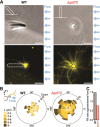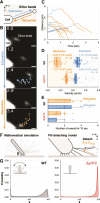Rapid water flow triggers long-distance positive rheotaxis for thermophilic bacteria
- PMID: 40748249
- PMCID: PMC12393216
- DOI: 10.1093/ismejo/wraf164
Rapid water flow triggers long-distance positive rheotaxis for thermophilic bacteria
Abstract
Bacteria thrive in nearly all environments on Earth, demonstrating remarkable adaptability to physical stimuli, as well as chemicals and light. However, the mechanisms by which bacteria locate and settle in ecological niches optimal for their growth remains poorly understood. Here, we show that Thermus thermophilus, a highly thermophilic non-flagellated species of bacteria, exhibits positive rheotaxis, navigating upstream in unidirectional rapid water flow. Mimicking their natural habitat at 70°C with a water current under optical microscopy, cells traveled distances up to 1 mm in 30 min, with infrequent directional changes. This long-distance surface migration is driven by type IV pili, facilitating vertical attachment at the cell pole, and shear-induced tilting of the cell body, resulting in alignment of the leading pole toward the direction of water flow. Direct visualization of type IV pili filaments and their dynamics revealed that rheotaxis is triggered by weakened attachment at the cell pole, regulated by ATPase activity, which was further validated by mathematical modeling. Flow experiments on 15 bacterial strains and species in the Deinococcota (synonym Deinococcus Thermus) phylum revealed that positive rheotaxis is highly conserved among rod-shaped Thermaceae, but absent in spherical-shaped Deinococcus. Our findings suggest that thermophilic bacteria reach their ecological niches by responding to the physical stimulus of rapid water flow, a ubiquitous feature in hot spring environments. This study highlights unforeseen survival strategies, showcasing an evolutionary adaptation to a surface-associated lifestyle where swimming bacteria would otherwise be swept away.
Keywords: Deinococcota; extremophiles; microfluidics; rheotaxis; twitching motility; type IV pili.
© The Author(s) 2025. Published by Oxford University Press on behalf of the International Society for Microbial Ecology.
Conflict of interest statement
The authors declare no conflict of interest.
Figures






Similar articles
-
Prescription of Controlled Substances: Benefits and Risks.2025 Jul 6. In: StatPearls [Internet]. Treasure Island (FL): StatPearls Publishing; 2025 Jan–. 2025 Jul 6. In: StatPearls [Internet]. Treasure Island (FL): StatPearls Publishing; 2025 Jan–. PMID: 30726003 Free Books & Documents.
-
A rapid and systematic review of the clinical effectiveness and cost-effectiveness of paclitaxel, docetaxel, gemcitabine and vinorelbine in non-small-cell lung cancer.Health Technol Assess. 2001;5(32):1-195. doi: 10.3310/hta5320. Health Technol Assess. 2001. PMID: 12065068
-
Electrophoresis.2025 Jul 14. In: StatPearls [Internet]. Treasure Island (FL): StatPearls Publishing; 2025 Jan–. 2025 Jul 14. In: StatPearls [Internet]. Treasure Island (FL): StatPearls Publishing; 2025 Jan–. PMID: 36251838 Free Books & Documents.
-
Type IV Pili in Thermophilic Bacteria: Mechanisms and Ecological Implications.Biomolecules. 2025 Mar 21;15(4):459. doi: 10.3390/biom15040459. Biomolecules. 2025. PMID: 40305182 Free PMC article. Review.
-
Elbow Fractures Overview.2025 Jul 7. In: StatPearls [Internet]. Treasure Island (FL): StatPearls Publishing; 2025 Jan–. 2025 Jul 7. In: StatPearls [Internet]. Treasure Island (FL): StatPearls Publishing; 2025 Jan–. PMID: 28723005 Free Books & Documents.
References
MeSH terms
Grants and funding
LinkOut - more resources
Full Text Sources
Medical

